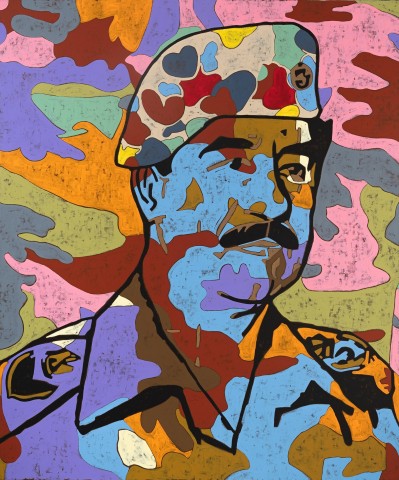CAMOUFLAGE #9, 2003
GORDON BENNETT
synthetic polymer paint on linen
182.5 x 152.0 cm
signed, dated, and inscribed with title verso: G Bennett 5 – 3 – 2003 / “CAMOUFLAGE #9” /…
Sherman Galleries, Sydney (stamped verso)
Gene and Brian Sherman, Sydney
Figure/Ground (Zero), Sherman Galleries, Sydney, 17 July – 9 August 2003, cat. 9 (illus. in exhibition catalogue)
Camouflage #7, 2003, acrylic on linen, 182.5 x 152 cm, in the collection of the Australian National University, Canberra
Camouflage #8, 2003, acrylic on linen, 182.5 x 152 cm, in the collection of the Australian War Memorial, Canberra
History painting was once considered the most noble of all genres, revered in the seventeenth century foremost for its ability to relate and record for posterity both the events of history and those of the artist’s lifetime. Gordon Bennett was a painter of history and histories. As a critically and politically engaged artist, Bennett’s paintings of the early 2000s diverged from his prior Australian subject matter, addressing instead events occurring far from our shores and finding within them analogous concerns of indigenous subjugation. Camouflage #9, 2003 comes from a series of reportage paintings catalysed by political and social anxiety following the 9/11 attacks and the subsequent War on Terror. The paintings feature portraits of the late Iraqi dictator Saddam Hussein in army fatigues alongside anonymous figures in hoodies and gas-masks, successively obscuring their features with an overlay of camouflage and decorative patterns. Camouflage #9, like its related works #8 and #7 (respectively in the collections of the Australian War Memorial and the Australian National University), clearly delineates Hussein’s features in thick black lines and carefully traces the outlines of his iconic military uniform.
Shown to critical acclaim in the Figure/Ground (Zero) exhibition at Sherman Galleries in Sydney, the Camouflage works are important historical documents. Created at the height of international paranoia over the existence of biological and chemical weapons of mass destruction, the Camouflage works appropriated a well-known portrait of Hussein. Camouflage #9 was painted in March of 2003, during a time when Hussein’s image was ubiquitous throughout Iraq and the Western media, and the dictator himself was in hiding. With a black commando beret poised cockily on his head and Republican Guard Field Marshall epaulettes adorning his military garb, this portrait encapsulated Hussein’s grandiose persona during his suffocating presidency. Bennett, however, creates a jarring visual experience by overlaying the portrait with a bright pattern of candy-coloured camouflage.
The confronting impact of these works has been inevitably altered by historical perspective, and our current knowledge of the chain of events that occurred since this painting was created. Bennett, through his use of distorting discordant patterns, comments on the ambiguity and subterfuge of political rhetoric that existed at the time around the casus belli of the War on Terror. Ian McLean, in his exegesis for the Figure/ Ground (Zero) catalogue, links Bennett’s criticism of political rhetoric in this series to the artist’s long-standing concern with Australian post-colonial perception of indigenous peoples, creating parallels between global and local terror.1 The artist, in a 2003 interview with Bill Wright, explained that the works were about ’colonial dominance’.2
Bennett was a quintessentially post-modern painter. His works employed a unique syntax that mined the vast contemporary visual landscape – appropriating historical works of art, images from mass media and iconography that was purely the artist’s own. Reminiscent of Andy Warhol’s last self-portrait, Camouflage Self-Portrait, 1986, in the collection of the Metropolitan Museum of Art, Bennett’s Camouflage works applied these patterns to progressively abstract the once iconic image of the dictator, until Camouflage #6, where only a silhouette remained. Bennett creates a ’veil’ for the dictator, shrouding the figure in secrecy, and as McLean notes, dehumanising his ubiquitous image with the ’iconoclastic retribution of defeat’.3
1. McLean, I., Camouflage, Figure/Ground (Zero), exhibition catalogue, Sherman Galleries, Sydney, 17 July – 9 August 2003
2. The artist in conversation with Bill Wright, cited in Gellatly, K., Gordon Bennett, exhibition catalogue, National Gallery of Victoria, Melbourne, 2007, p. 105
3. McLean, I., ibid.
LUCIE REEVES-SMITH
